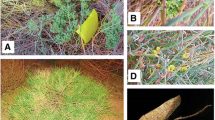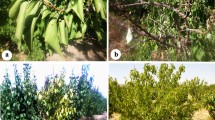Abstract
Chinese scholar tree (Sophora japonica) with witches’ broom symptoms was observed in Shandong Province in China. Phytoplasmas were detected in the diseased plants using 16S rDNA amplification with phytoplasma-specific universal primer pairs. On the basis of the results of 16S rDNA sequencing, virtual restriction fragment length polymorphism patterns and phylogenetic analyses, the phytoplasma found in S. japonica with witches’ broom symptoms was confirmed as a ‘Candidatus Phytoplasma ziziphi’-related strain belonging to the Elm yellows group 16SrV. This is the first report of ‘Ca. P. ziziphi’ infecting S. japonica plant with witches’ broom symptoms.


Similar content being viewed by others
References
Cai H, Wei W, Davis RE, Chen H, Zhao Y (2008) Genetic diversity among phytoplasmas infecting Opuntia species: Virtual RFLP analysis identifies new subgroups in the peanut witches’-broom phytoplasma group. Int J Syst Evol Microbiol 58:1448–1457
Duduk B, Tian JB, Contaldo N, Fan XP, Paltrinieri S, Chen QF, Zhao QF, Bertaccini A (2010) Occurrence of phytoplasmas related to Stolbur and to ‘Candidatus Phytoplasma japonicum’ in woody host plants in China. J Phytopathol 158:100–104
Gundersen DE, Lee IM (1996) Ultrasensitive detection of phytoplasmas by nested-PCR assays using two universal primer pairs. Phytopathol Mediterr 35:144–151
IRPCM (2004) ‘Candidatus Phytoplasma’, a taxon for the wall-less, non-helical prokaryotes that colonize plant phloem and insects. Int J Syst Evol Microbiol 54:1243–1255
Lee IM, Gundersen-Rindal DE, Davis RE, Bartoszyk IM (1998) Revised classification scheme of the phytoplasma based on RFLP analyses of 16s rRNA and ribosomal protein gene sequences. Int J Syst Bacteriol 48:1153–1169
Li Z, Wu Z, Liu H, Hao X, Zhang C, Wu Y (2010) Spiraea salicifolia: a new plant host of “Candidatus Phytoplasma ziziphi”-related phytoplasma. J Gen Plant Pathol 76:299–301
Tamura K, Dudley J, Nei M, Kumar S (2007) MEGA4: molecular evolutionary genetics analysis (MEGA) software version 4.0. Mol Biol Evol 24:1596–1599
Acknowledgments
This work was supported in part by grants from the National Natural Science Foundation of China (30972367 and 30671685) and the Foundation to Distinguished Young Scientists in Shandong Province (BS 200606017).
Author information
Authors and Affiliations
Corresponding author
Rights and permissions
About this article
Cite this article
Yu, ZC., Cao, Y., Zhang, Q. et al. ‘Candidatus Phytoplasma ziziphi’ associated with Sophora japonica witches’ broom disease in China. J Gen Plant Pathol 78, 298–300 (2012). https://doi.org/10.1007/s10327-012-0385-7
Received:
Accepted:
Published:
Issue Date:
DOI: https://doi.org/10.1007/s10327-012-0385-7




